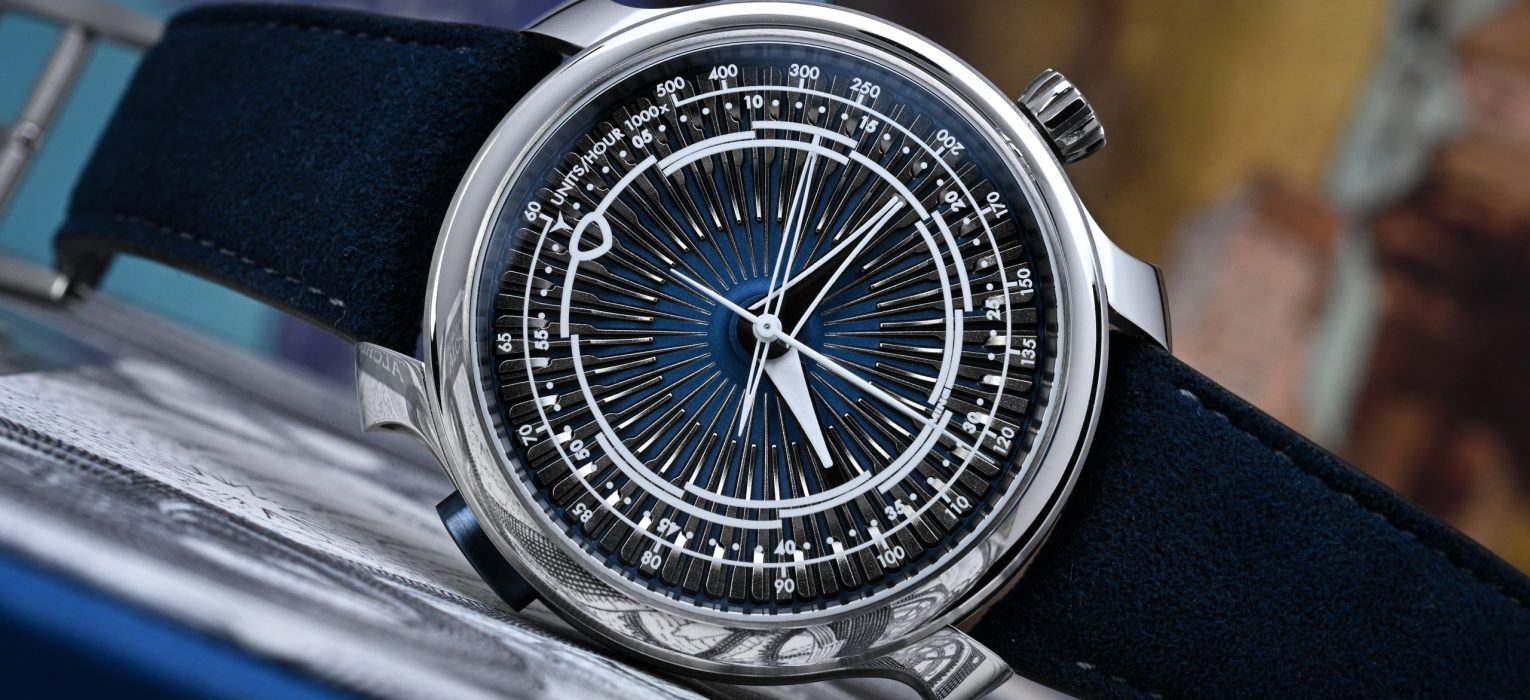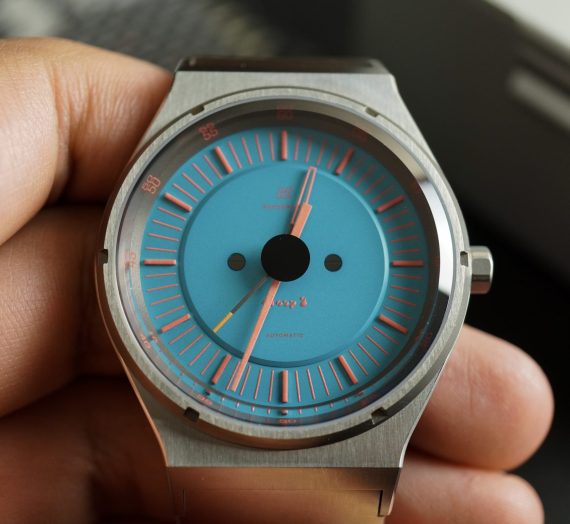Disclaimer: this video/review was not sponsored by MING or any other entity.
Video
Review
If you’ve been following my channel for a while, you probably already know that the MING 20 Series is easily one of my favorite families from the brand. It perfectly captures everything I love about MING: bold design, technical ingenuity, and a strong identity. And within that lineup, the 20.01 has always stood out as my personal favorite. It houses one of my all-time favorite modern chronograph movements, the Agenhor Agengraphe, and presents it in a way that feels unmistakably MING… thoughtful, refined, and futuristic.
I’ve often said that MING watches feel like they’re plucked straight out of a science fiction universe. There’s something about their design language: the sculpted forms, intricate layering, and subtle luminescent details, that gives them an otherworldly quality. They manage to balance artistic restraint with a kind of mechanical imagination that reminds me why I love science fiction in the first place.

With the new 20.01 S5, MING leans into that influence more explicitly than ever before. The brand has hinted at inspiration from Star Wars and Dune, and once you see the dial, it’s hard to miss. It’s a stunning mechano-organic hybrid that feels like a cross between the Death Star and Shai Hulud… and I’d be lying if I said that didn’t make me love it even more.
Limited to just 25 pieces and priced at 37,500 CHF, the 20.01 S5 features the same intricate case architecture as its predecessors, but now crafted in stainless steel with blue PVD-coated pushers that echo the deep tones of its dial. It is currently available at the time of writing this review, but may not be at the time of publishing it, because producing these reviews is taking a bit longer than usual these days due to other commitments.
Let’s check it out!
Case
The MING 20.01 S5 carries forward the brand’s signature 20 Series case design, which I’m already quite familiar with from my own 20.11 Mosaic and the 20.01 S2 and S3 that I’ve previously reviewed. My measurements put the case at 41.5mm in diameter, 45.5mm lug-to-lug, and approximately 14.25mm thick: dimensions that might sound substantial on paper, but thanks to MING’s thoughtful case architecture, the watch wears much slimmer than expected. Unlike the rose gold construction of the S3, and the titanium S2, the S5 features a stainless steel outer structure paired with a grade 5 titanium inner case, offering a practical twist on the familiar design.
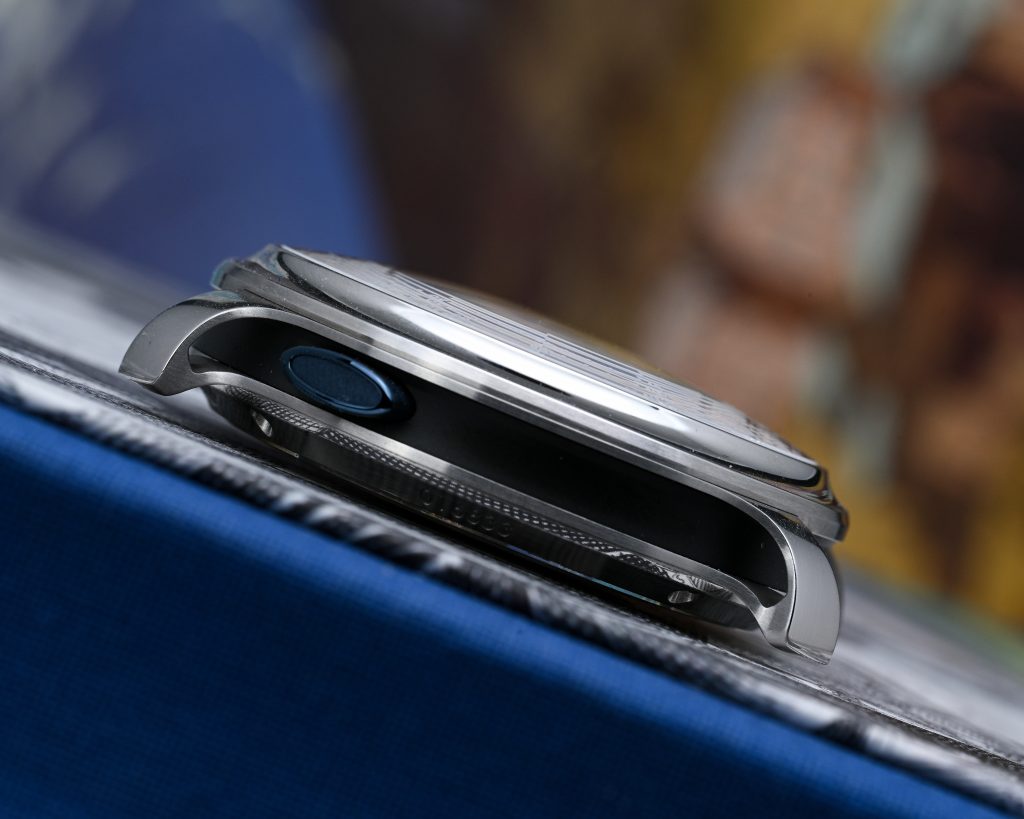
The 20 Series case remains a complex feat of engineering, composed of 34 individual parts, each demonstrating a range of finishing techniques that highlight MING’s meticulous attention to detail. My favorite design element continues to be the hollowed-out mid-case and sculpted lugs, which do a fantastic job of minimizing the visual bulk that a 14.25mm thickness could otherwise bring.
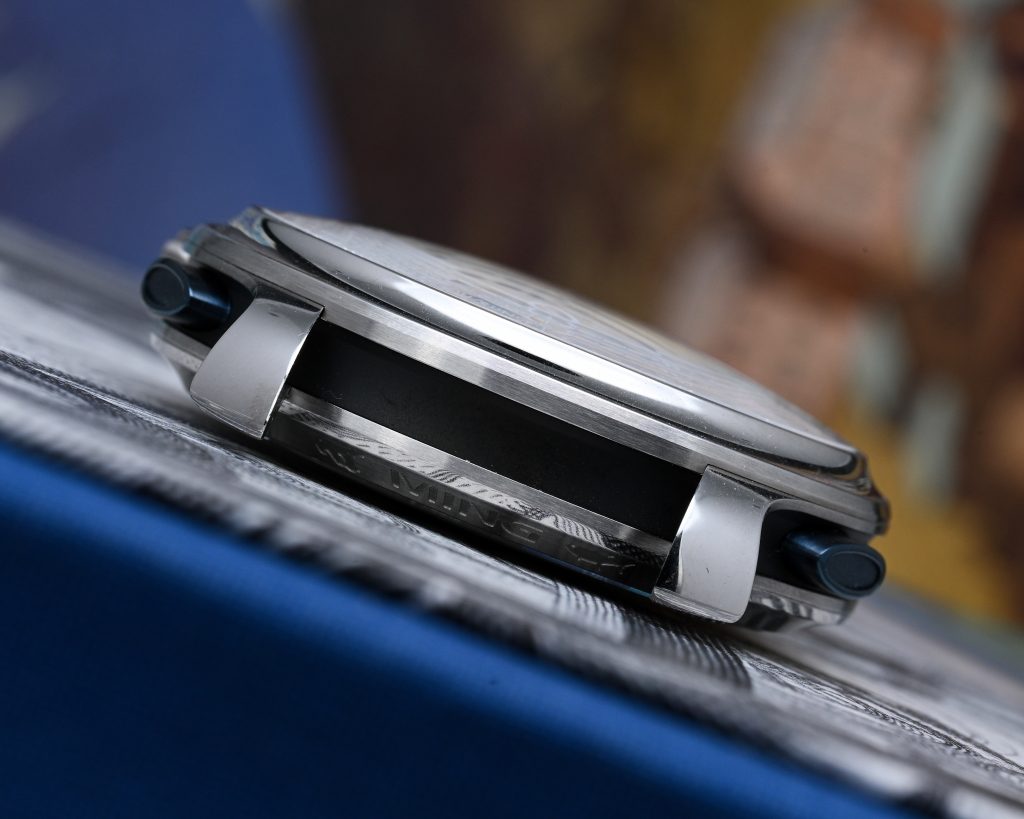
The sapphire crystals, a slightly curved one on top and a flat one at the back, both feature generous anti-reflective coatings, ensuring clarity and excellent visibility in any light. The chronograph is operated via pushers positioned at the top left and top right, now PVD-coated in a deep blue to complement the dial, while the 5.4mm push-pull crown at 4 o’clock remains easy to grip and operate.
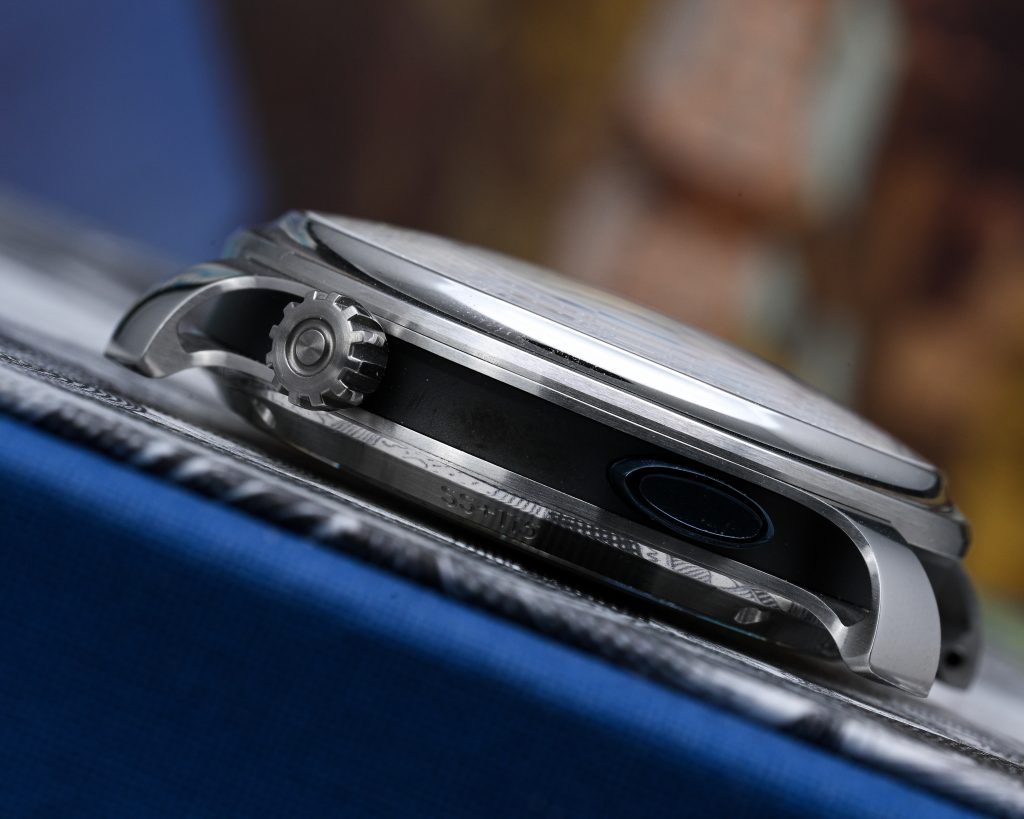
As with all MING watches, the 22mm lugs only support curved spring bars. Finally, the 50m water resistance rating provides sufficient protection for daily wear: more than adequate for a watch of this refined yet technical nature. Overall, the execution of the case design and finishing remains exceptional, reaffirming my belief that MING continues to produce some of the most visually striking and intelligently engineered cases in independent watchmaking.
Dial
When I reviewed the 20.01 S3, I was blown away by the sheer spectacle of its borosilicate glass dial and the incredible amount of lume it carried. It was a visual masterpiece: luminous, layered, and unlike anything else I’d seen. But I’d be lying if I said it was very legible. Beyond reading the hours and minutes, the chronograph operation was difficult to follow, sacrificed in favor of that hypnotic display of light and depth. So when MING announced the 20.01 S5, I was a little apprehensive. The early photos made me worry it might follow the same path. Fortunately, I couldn’t have been more wrong.
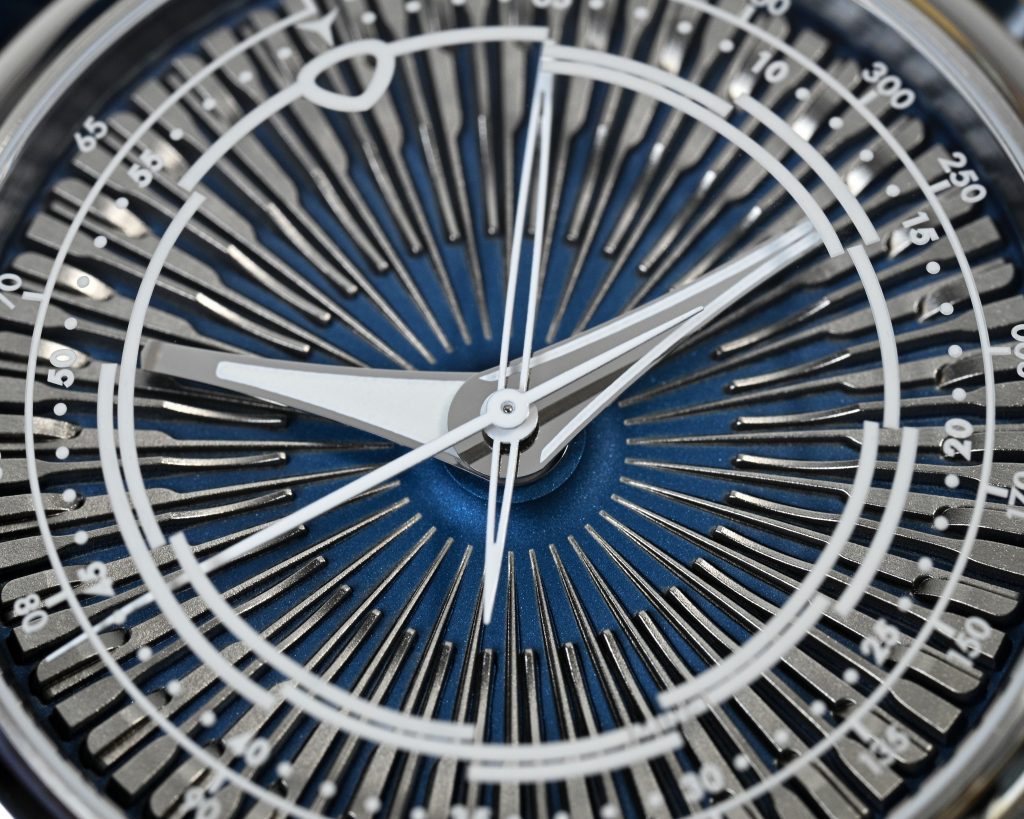
In person, the S5 has no problems with legibility. There’s excellent contrast between the floating sapphire chronograph tracks and the dark, matte blue dial below, which gives the display a clear sense of hierarchy. You can easily distinguish the floating chronograph track from the dial below it, and I hope some of my photos can convey how well this balance has been struck. The overall dial layout feels familiar, with the same hand design and scale as the S3, but the hour marker ring has been reworked. It now echoes the asymmetric style seen on the 37.02 Minimalist and, more recently, the 57.04 Iris.

The real star of the show, though, is the dial itself; a single block of titanium that’s been laser-milled into an impossibly intricate three-dimensional landscape. The process is staggering: complex radial strakes radiate from the center, each interlocking with its neighbors through curves and varying elevations that catch light in mesmerizing ways.
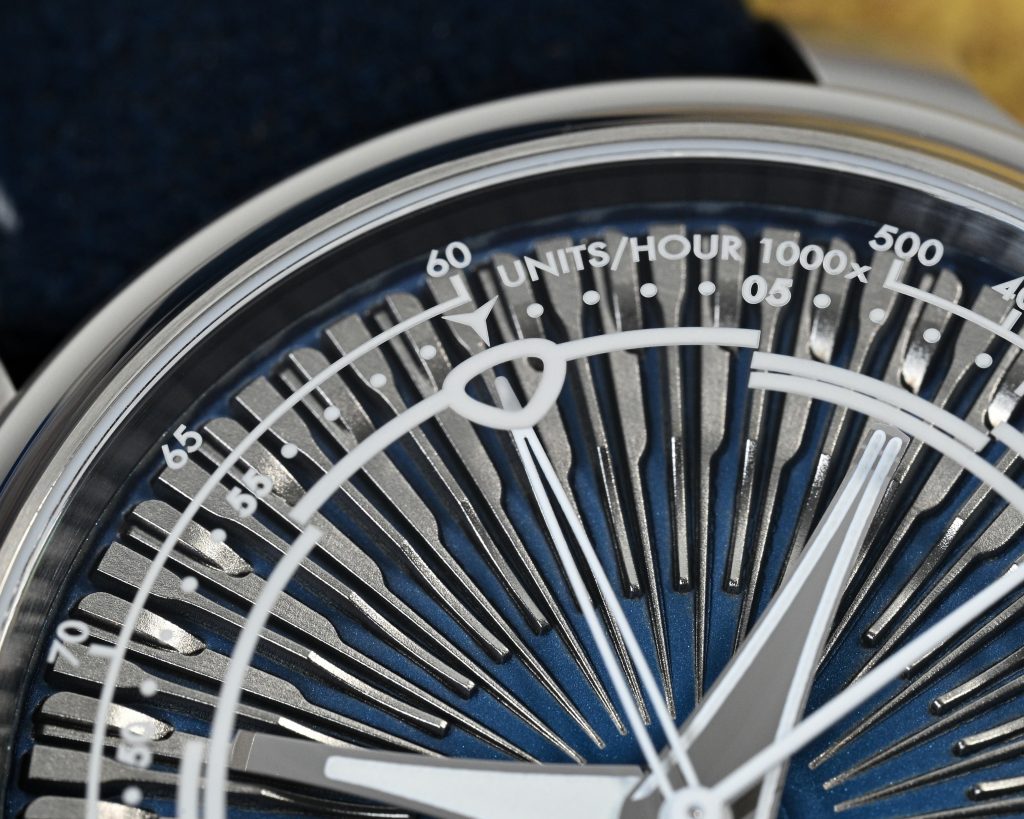
Most of these spikes are bead-blasted, matching the flat surface beneath, which is also bead-blasted and PVD-coated in deep blue. After coating, the dial undergoes another round of lasering to strip the tops of the strakes back to raw titanium, revealing a stonewashed texture that shimmers subtly as the light shifts.
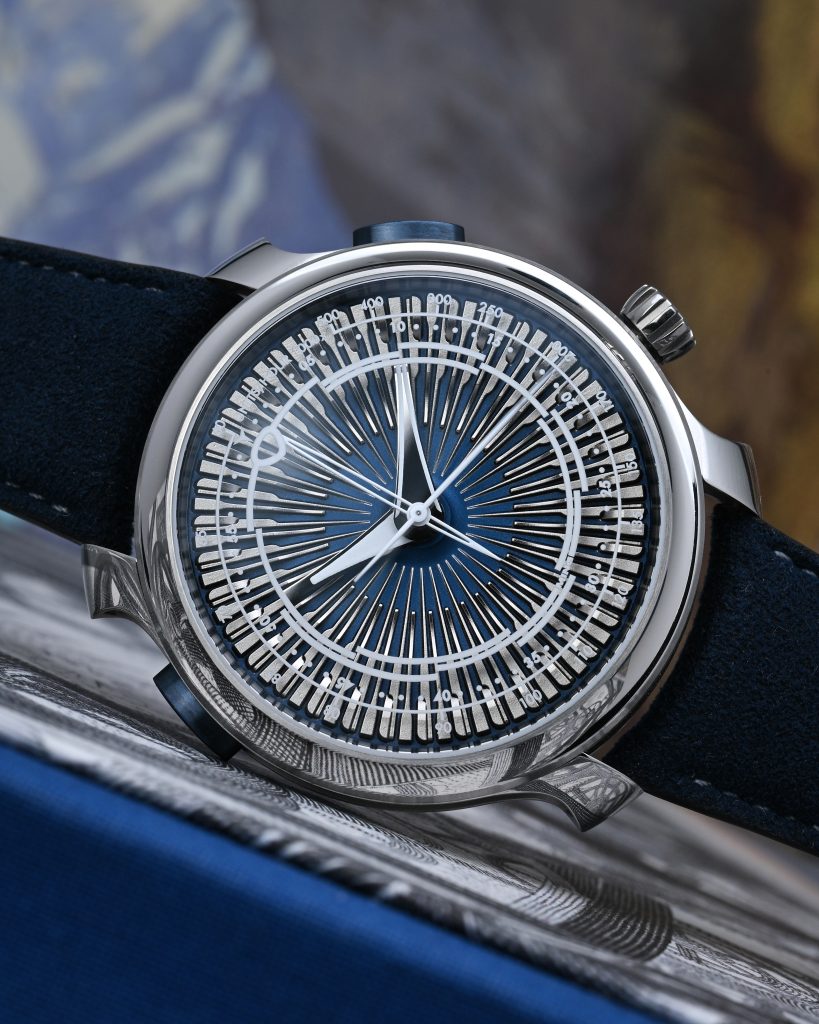
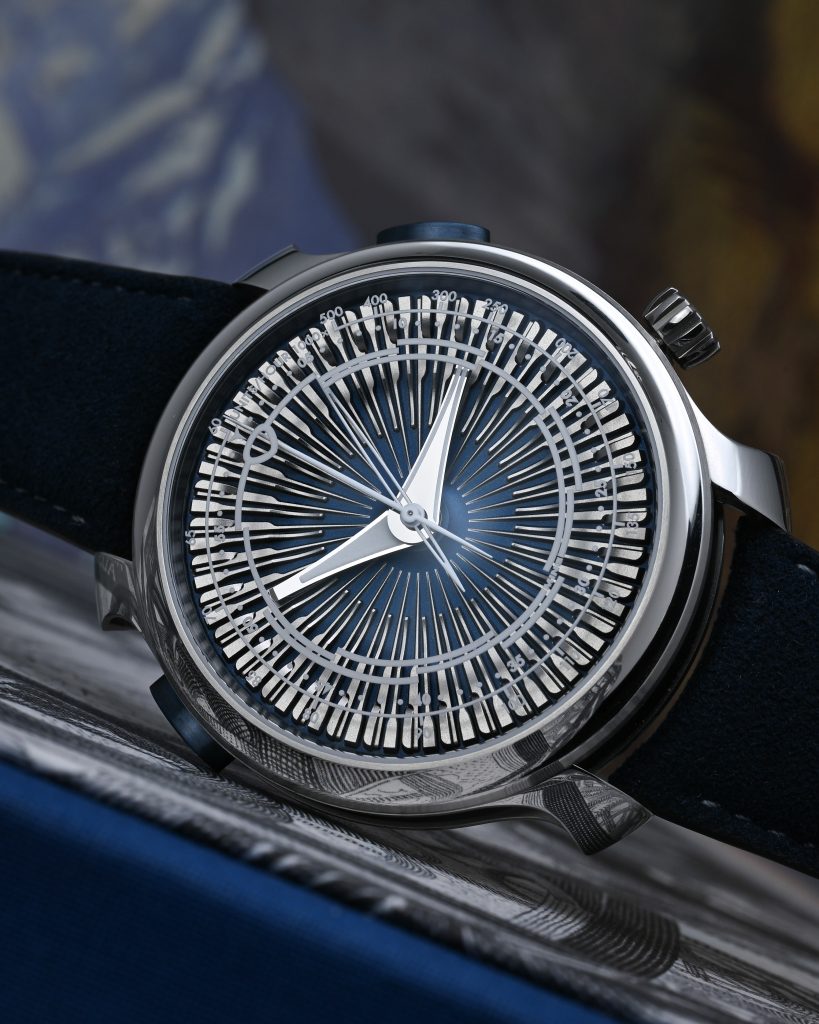
It’s an extraordinary feat of machining and finishing: one that feels both futuristic and organic, like something that could sit at the center of a sci-fi plot. The result is absolutely breathtaking in person, and even more so under a loupe or macro lens. I had an absolute blast photographing this dial, and I think it perfectly captures what makes MING such a special brand: technical ingenuity, artistic boldness, and an unwavering commitment to turning imagination into tangible form.
Lume
The MING 20.01 S5 carries forward the brand’s exploration of luminous materials with its use of MING Polar White lume, this time applied directly into etched grooves on the underside of the sapphire crystal. Both the minimalist-style hour marker ring and the chronograph scale use this pigment, creating a subtle, ethereal glow that feels distinctly MING.
Compared to the HyCeram-based lume seen on other models, this application is less intense: the crystal fades faster than the traditionally lumed hour and minute hands, and the chronograph hands aren’t lumed at all. Still, the Polar White lume adds a beautifully surreal personality, more diffused and ambient than bright, which doesn’t necessarily detract from the futuristic design language of the watch.

Viewed up close, individual particles within the lume fade into slightly different hues as they lose charge, hinting at the complex chemistry behind achieving a true white glow. I’d love to see MING boost the brightness and longevity in future releases.
Movement
I’m going to echo exactly what I said about this movement in my review of the 20.01 S3. It is something truly special, and I find it to be one of the most impressive modern chronograph designs. Before diving in, I should mention that my understanding of the AgenGraphe has been shaped by excellent articles from Ian Skellern on Quill & Pad, Jack Forster on 1916 Company, and various technical documents and reviews from Agenhor and brands that use this movement, like Fabergé, Singer, and H. Moser & Cie.

Designed by Jean-Marc Wiederrecht, the AgenGraphe was built from the ground up, unlike many high-end chronograph movements today that are largely refinements of classic architectures from Lemania, Valjoux, and others. This movement successfully modernizes the chronograph while addressing many of the drawbacks of traditional designs. One of its defining features is its central chronograph display, where the elapsed time hands for minutes and seconds are positioned concentrically on the dial -allowing for immediate, intuitive legibility without the clutter of multiple subdials. While other brands like Sinn, Damasko, and Habring have attempted central chronographs based on Valjoux or ETA movements (often inspired by the Lemania 5100), the AgenGraphe does it in a way that feels truly innovative.
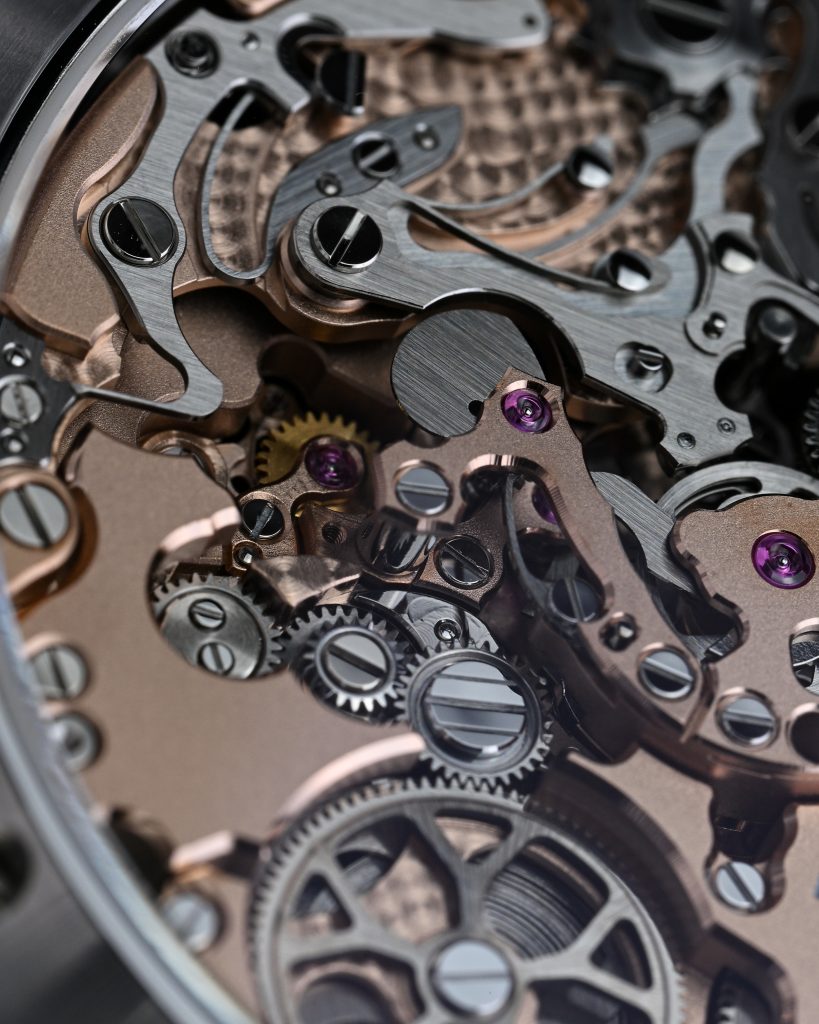
At its core, it uses a column wheel for precise function control but replaces conventional clutch systems with the AgenClutch, a lateral friction clutch with no teeth, ensuring ultra-smooth engagement with no start-up jitter or amplitude drop. The jumping minutes mechanism, driven by snail cams, eliminates any ambiguity in reading elapsed time and ensures constant torque for smooth operation – something many older chronographs struggle with. Additionally, instead of the abrupt, hammer-driven reset found in traditional chronographs, the AgenGraphe employs a brake-release reset, where a spring gently rewinds the chronograph hands back to zero, preventing the jarring snap-back that can stress components over time.

The movement architecture itself is also unconventional: rather than the traditional layered chronograph layout, it features an annular main movement with a hollow center, where the chronograph mechanism is stacked – a design that usually includes a dial-side rotor, though MING opted for a manually wound variant for the 20.01 models. Over the years, my appreciation for chronograph movements has only grown – they embody everything I love about watchmaking, from intricate mechanical design to clever engineering solutions. Many modern chronographs feel uninspired in comparison to the highly architectural designs of the past, but the AgenGraphe manages to be both modern and robust while maintaining the sculptural elegance of vintage calibers.
On The Wrist
Having worn a 20 Series Mosaic for over two years, the 20.01 feels instantly familiar and comfortable on the wrist. The generous use of sapphire, and the titanium inner core makes this watch feel much lighter than you would expect from a watch that is being sold as a stainless steel model given its stainless steel outer case. The proportions are well-balanced for my 6.75″ wrist, with the 41.5mm case diameter sitting perfectly.
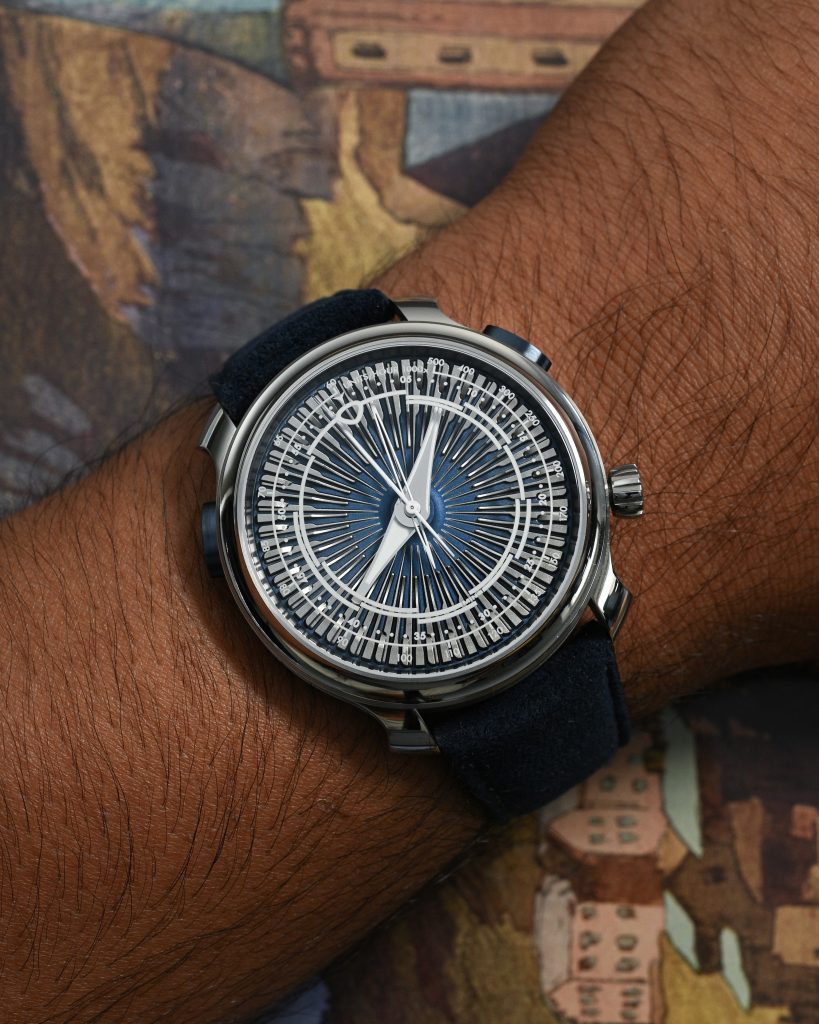

The 14.2mm thickness might seem hefty on paper, but the rounded crystal and cleverly sculpted mid-case, with its hollowed design, make it wear much slimmer than you’d expect. It sits comfortably, and I don’t feel any of the usual bulkiness that might come with a watch of this size. A 22mm bracelet is available that would fit this watch, but it is made of Grade 5 Titanium, so those that are very picky about mismatched metals might want to avoid that.
Wrapping Up
The MING 20.01 S5 is without question a niche watch, priced at 37,500 CHF and produced in a tiny batch of just 25 pieces. It isn’t meant to appeal to everyone, and that’s exactly what makes it so compelling. It’s a piece for those who value design experimentation, modern materials, and mechanical brilliance in equal measure. Between its beautifully engineered 20 Series case, the fascinating use of MING’s experimental Polar White lume, and the astonishingly intricate titanium dial, this watch feels like a masterclass in forward-thinking design.
At its core beats the remarkable Agenhor Agengraphe movement, housed within a case that exemplifies MING’s meticulous approach to form and proportion. Together, these elements create a watch that feels undeniably futuristic. For collectors who have already experienced the traditional heavyweights of haute horlogerie and now seek something more daring, the 20.01 S5 represents the cutting edge of modern independent design, and proof that true innovation in watchmaking is alive and well.

